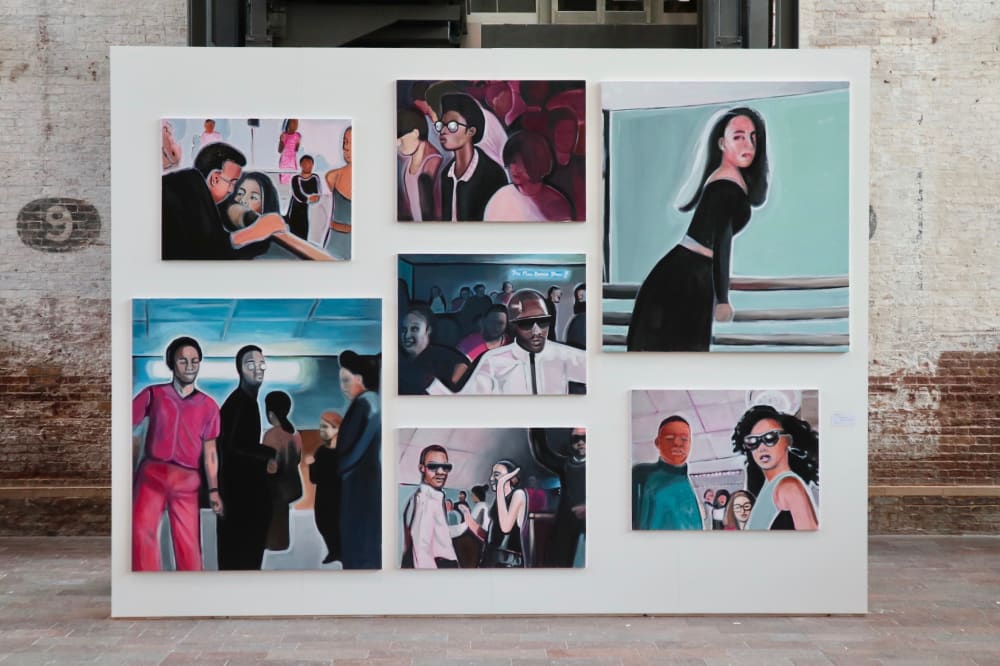Our graduating students share the process behind their practice. Here, Madelynn Mae Green takes us to Detroit in the late 80s through the prism of paint and nostalgia.
Graduating from MA Fine Art, Madelynn Mae Green presents an installation of paintings depicting nightclub scenes, called Detroit, 1989. Through her practice she pulls imagery out of obscurity – from video and photographs – reinterpreting them on canvas. Her work was selected for New Contemporaries 2018 and was recently acquired by the UK Government Art Collection.

Dance
I find that the subject of dance lends itself well to painting. When making the work, I consider the concept of rhythm, as it appears in both dance and in painting. This subject is also personal; my father and grandmother were DJs in Chicago's house music scene.
Detroit, 1989 is based on video clips of The New Dance Show, a local television series in Detroit that began in 1988 as a contemporary version of Soul Train. The low-budget show cast a spotlight on Detroit’s burgeoning techno and house music scenes. It aired only in Detroit and, like Soul Train, featured regular dancers and a charismatic host. All episodes of are available online, but I chose to focus on one episode of The New Dance Show, tracking the characters, relationships and scenes that played out over a single, microcosmic night.
Nostalgia
My source material for paintings includes videos as well as photographs. I am drawn to the aesthetics of old pre-digital images, for the forces of nostalgia, memory, and time that they evoke. I try to communicate these forces in my paintings. This is inspired by philosopher Gilles Deleuze’s observation that a “good” painting successfully captures forces. Bell Hooks’ view of photographs in African-American culture as more than just pictures, but instead “pictorial genealogies” on a par with classical paintings, helped reinforce informal photographs and videos as integral to my practice.
Paint
I distort colour, lighting, and work layer by layer to create alternative, intentionally fabricated versions of reality: paint drips, ground is left visible, and forms are ambiguous to emphasise "constructedness".
Obscured histories
Detroit, 1989, captures the overall essence and aesthetics of a significant, yet obscured era of music, expression, and fashion in African-American and – more broadly – American history and culture. More than a time and place, Detroit, 1989 is a cultural concept and an ethos. It signifies an explosion of the ground-breaking techno music that was born in the city and the growing popularity of clubs and raves as sacred, sensational spaces in the midst of political and cultural turmoil. It reveals the global proliferation of African-American culture as well as the interconnectedness of youth during this era; they were dancing to similar music and wearing similar attire, despite the absence of internet and cellphones to facilitate rapid cultural exchange.

Performance
The impact of the paintings, hung salon-style, mimics the ostentatious and chaotic energy of that night in Detroit. Despite this bold excitement, there is an interplay between public and private in these paintings; some depict intimate moments between individuals while in others the dancers coolly show themselves off, signalling awareness of the camcorder by putting on a spectacle. The dancers' cognizance of the significance of their unique cultural moment, as evidenced by their showing off for the camera, perhaps signals their desire to preserve these precious moments for posterity's sake, in a way inviting future artists like myself to capture it all.
Madelynn Mae Green's work can be see in Show One: Art, 22-26 May, at Central Saint Martins.



